This information has been commissioned by the Goulburn Murray Valley (GMV) Fruit Fly Program and is funded by the Victorian Government. Use of this material in its complete and original format, acknowledging its source, is permitted, however unauthorised alterations to the text or content is not permitted.
Fruit fly overview
- Queensland fruit fly numbers remained higher than normal across the Goulburn Murray Valley for the first half of May but fell to average levels in the second half of May due to sudden cooler conditions occurring during mid-May. Weather conditions including the second La Niña weather event in a row and more unharvested and fallen fruit than usual contributed to increased autumn activity.
- Cold weather occurring in the Goulburn Murray Valley from mid-May onwards did not reduce fruit fly populations significantly. Fruit fly adults remain on the landscape in refuges – it’s just too cold for them to fly into traps.
- During the winter period empty traps do not mean there are no fruit fly in your garden or orchard.
- Higher than normal May fruit fly numbers were due to high numbers in rural, peri-urban and urban locations. This was due to the higher-than-average numbers that started in February 2022 and continued to mid-May.
- Autumn numbers were very high in peri-urban sites during 2022 – the highest since project commencement.
- Individual traps rather than more widespread areas skewed data significantly – 47% of fruit fly trapped in autumn 2022 were from just 30 of the 300 traps on the grid (NOTE: Cobram traps were excluded due to the SIT release project there).
- Weather outlooks favour the survival of overwintering Queensland fruit fly in the Goulburn Murray Valley.
- The Goulburn Murray Valley fruit fly trapping grid is an essential tool for identifying hot spots, timing of fruit fly management activities and evaluating the efficacy of Area Wide Management programs including SIT.
Goulburn Murray Valley regional assessment
Unusually for this time of year fruit fly numbers remained very high during early May with over 3,000 Queensland fruit fly trapped per month from February to May. Up until February 2022 the 2021/22 fruit fly season was shaping up to have low fruit fly numbers. There was a significant increase in populations in February which was favoured by cooler maximum temperatures and more rainfall. This signaled the second year in a row with a La Niña weather pattern. Queensland fruit fly thrive during La Niña events in South-East Australia.
Several factors may have contributed to this expansion in fruit fly numbers:
- Higher than normal mid-morning temperatures for this time of year. Queensland fruit fly tend to go to traps in the morning.
- Higher than normal dusk temperatures. Queensland fruit fly mate at this time as long as temperatures at dusk are above about 16˚C. This allows adult flies to extend their activity season.
- Higher availability of ripe and ripening fruit possibly due to much fruit remaining unharvested, dumped or windfallen due to COVID restrictions on pickers and warmer daily temperatures.
- Lasting impacts of the La Niña weather pattern which tended to more rain and higher autumn temperatures all of which favoured fruit fly survival and expansion.
Rural locations
Fruit fly trap numbers in locations of the Goulburn Murray Valley were very high during 2020/21 especially from February onwards. Queensland fruit fly numbers for 2021/22 were, in general, like those from 2020/21 except that peak monthly fruit fly captures occurred a month later this year. Weather conditions which were favourable to fruit fly have persisted longer this year than normal allowing a high level of fruit fly to survive throughout autumn to mid-May (Fig. 2).
Peri-urban locations
Queensland fruit fly numbers reached high levels during 2021/22 but peak trap captures were not as high as last season (Fig. 3).
Urban locations
Numbers peaked in urban sites during early February 2022 (Fig. 4). This is unusually late as fruit fly populations generally peak in December/ January. It’s likely that this is due to an extended spring with cool temperatures persisting into late spring last year.
Figures 2, 3 and 4 show when Queensland fruit fly peaks occurred in the different land use types. Fruit fly peaks occur early in urban areas, mid-season in peri-urban locations and later in rural sites. One conclusion is that Queensland fruit fly move from urban sites, through peri-urban and into rural locations during the season. Possibly this is due to seasonal and the range of fruit availability starting in urban areas, then dying off with fruit fly moving into rural regions when high fruit volumes start to ripen.
Townships
Table 1 gives a ranking of the highest to lowest averages of fruit fly/trap for each trapped location within the Goulburn Murray Valley during autumn 2022. It shows that some areas have high averages.
As mentioned above, Queensland fruit fly is not evenly spread over these areas. Of the 8 traps servicing Undera only 1 trap accounts for over 72% of fruit fly trapped during 2021/22. Of the 19 traps in Orrvale there are 2 that make up nearly 52% of total catches for that town.
Hot spots for May/June 2022
Goulburn Murray Valley locations with significant hot spots for May to June 2022 were as follows:
Table 1. Goulburn Murray Valley hot spots (i.e. sites ranked Very High or High)
| VERY HIGH | HIGH |
| BUNBARTHA | ARDMONA |
| GRAHAMVALE | KATUNGA |
| INVERGORDON | MOOROOPNA |
| KYABRAM | YARROWEYAH |
| MERRIGUM | |
| NAGAMBIE | |
| ORRVALE | |
| SHEP EAST | |
| SHEP | |
| TATURA | |
| TOOLAMBA | |
| UNDERA |
Weather up to mid-June 2022
Figures 5, 6 and 7 compare average 15-day temperatures (max. and min.) and total 15-day rainfall for Cobram Post Office comparing data for 2018/19 and 2021/22 which were collected from SILO Australian climate data from 1889 (accessed 15 June 2022). Spring temperatures for 2021/22 were generally lower than those for 2018/19 by up to 3˚C to 5˚C. This possibly resulted in delayed commencement and expansion of fruit fly populations but, at the same time, encouraged fruit fly survival in greater numbers, until temperatures returned to more normal levels in early February. Numbers of fruit fly on the landscape were able to build up to high numbers by February. Queensland fruit fly survival and build-up was further facilitated by higher-than-average rainfall (Table 3) as this reduced desiccation stress on the insects as well as for fruiting crops – higher fruit fly survival, more crop set, heavier crop production, more hosts for fruit flies to infest, more fruit fly emergence.
Table 2. Total rainfall (mm) at Cobram Post Office from 1 July to mid-June of the following year from July 2018 to Mid-June 2022.
| Qfly season (1 July to mid-June) | Total rainfall (mm) |
| 2018/19 | 298.4 |
| 2019/20 | 461.1 |
| 2020/21 | 474.2 |
| 2021/22 | 605.0 |
Weather outlook for June and July 2021
The Bureau of Meteorology, (accessed 25 May 2021) gives the following outlook for the Goulburn Murray Valley for two-week period from 18 June to 1 July 2022:
Rainfall: 30% to 35% chance of more rain than average (15mm to 25mm)
Maximum temperature: 65% to 75% chance of higher than average (12˚C to 15˚C)
Minimum temperature: 70% to 80% chance of higher than average (3˚C to 6˚C)
The Bureau of Meteorology, (accessed 25 May 2021) gives the following outlook for the Goulburn Murray Valley for the month of July 2022:
Rainfall: 70% to 80% chance of more rain than average (25mm to 100mm)
Maximum temperature: 45% to 55% chance of higher than average (12˚C to 15˚C)
Minimum temperature: 70% to 80% chance of higher than average (3˚C to 6˚C)
These weather outlooks indicate fruit fly will be able to survive at least this part of winter in greater numbers than normal.
Caution: The above mentioned forecast weather conditions point to the probability that fruit fly will survive in the Goulburn Murray Valley in greater numbers than in previous colder, drier years. It is very important to make sure all fruit and fruiting vegetables are harvested and used or picked up and destroyed.
Winter temperatures and higher than normal rainfall favour population build up. Home heating, which artificially raise localised relative humidity and temperatures (close to the house) will improve the survival of fruit fly eggs, larvae, pupae and adults at that site.
Queensland fruit fly outlook for June/July 2022 – home gardens
Things to do in June/Jul 2022
- Pick up and dispose of (plastic bag in the sun for 5 days and then throw out with the weekly garbage or compost) any fallen fruit that may be in your yard, on the nature strip, on nearby creek banks or parks.
- Pick any fruit still on the plant and either use or dispose of as above.
- Prune your trees to keep them at a manageable height for next season’s fruit picking or for netting.
- Check ripe and ripening fruit for signs of fruit fly infestation – soft patches, brown to black sting marks, maggots. If found, pick the fruit and dispose of it as above.
- If you have traps out – whether they are male-targeting (parapheromones e.g. cuelure) or female-targeting (food-based e.g. yeast or other protein source), make sure that they are within the use-by date. If not, put new ones out or recharge them with new baits.
- If you don’t have traps out consider putting a few around the house, especially in evergreen foliage near the house, the chook yard or the compost heap – e.g. the lemon tree.
- Netting around most trees can be removed now but keep it there if you have ripe or ripening fruit still in your yard. Remember that olives can be attacked by fruit flies when they are black and ripe.
- If you have fruit trees that you don’t use – e.g. feijoa, guava – consider removing them completely and replacing them with an attractive non-fruiting plant.
Queensland fruit fly outlook for June/July 2022 – commercial horticulture
If your property is close to (within 500m) of urban or peri-urban fruit fly host plants, or feral hosts along roads or channels or in abandoned orchards, particularly if you are close to any of the GMV hot spots (Table 2) you should keep a very close watch on:
- Fruit fly traps (both male and female targeting), deployed all year round. Check your traps at least once a fortnight during autumn and winter and every week from August/September onwards.
- Any ripe or ripening fruit (in your orchard, in your house yard, including the front yard, or along the road or channel bank) that might show signs of infestation (e.g. sting marks, abnormal fruit softening). Please check your fruit (for sting marks and/or eggs and larvae inside them at least once a week.
- If you have had fruit fly problems previously it is advisable to ensure you have access to suitable quantities of fruit fly bait so that if (or when) fruit flies are found in fruit or in high numbers on traps you can commence, your baiting program straight away.
- Ensure your orders for fruit fly baits and, if necessary, fruit fly cover sprays, have been sent into your supplier.
Note: There will be little fruit fly activity observed in traps and in infested fruit from mid-May to late August in the Goulburn Murray Valley due to cold conditions. It should be remembered that weather conditions vary considerably from area to area and while it may be cold in one area temperatures or rainfall may be higher in another. A few degrees higher than average, due to geographical location, may encourage fruit fly activity even infestation at that site while other cooler areas will not. It is important to keep watch on fruit fly along with the local weather.
Growers are advised to maintain (or, if not done yet, purchase and place out) their male- and female-targeting fruit fly traps and manually check any ripening fruit in their house yards, orchards or nearby for fruit fly infestations. Growers should also ensure they have timely access to approved fruit fly baits and pesticides should trap numbers and/or fruit infestations increase in severity. Your local Fruit Fly Coordinator, staff from produce stores and Agriculture Victoria can provide advice.
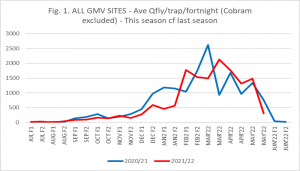
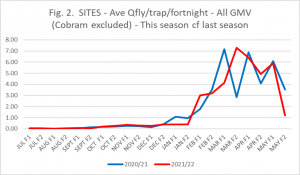
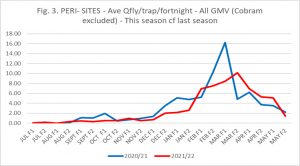
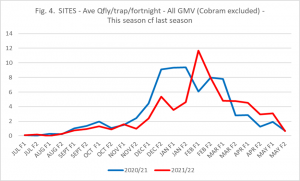
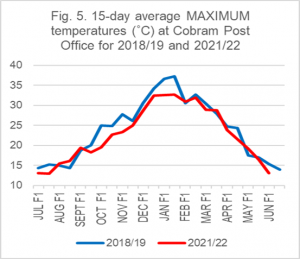
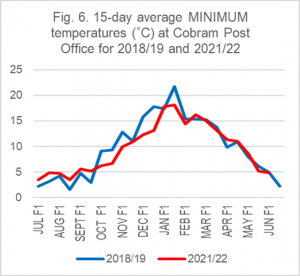
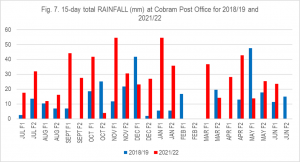
Goulburn Murray Valley Fruit Fly Program
For assistance in managing fruit fly, contact the Project Coordinator at the GMV Fruit Fly Office by phoning (03) 5871 9222 or email gmvfruitfly@moira.vic.gov.au.
This report was produced and supplied by Janren Consulting Pty Ltd for the purpose of the Goulburn Murray Valley Fruit Fly Program. The Goulburn Murray Valley Fruit Fly Area Wide Management Program is supported by the Victorian Government.
